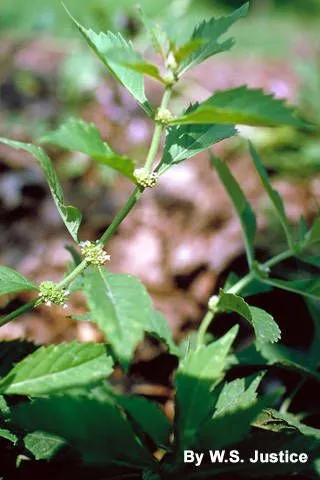
Author: L.
Bibliography: Sp. Pl.: 21 (1753)
Year: 1753
Status: accepted
Rank: species
Genus: Lycopus
Vegetable: False
Observations: C. & E. U.S.A.
Water horehound, scientifically known as Lycopus virginicus, is a perennial herbaceous plant that belongs to the Lamiaceae family. It holds a place of particular significance within the botanical community due to its distinct characteristics and widespread presence, primarily observed across central and eastern regions of the United States.
This resilient plant thrives in a variety of damp habitats, including marshlands, riverbanks, and wet meadows, showcasing its adaptability to environments with consistent moisture. Its natural preference for such areas underscores its role in contributing to the ecological diversity found within these wetlands.
Water horehound can be identified by its square stems—a hallmark of the mint family—and its toothed, lance-shaped leaves which are arranged oppositely along these stems. The plant often grows to a height of approximately 1 to 2 feet, though it can occasionally reach up to 3 feet under optimal conditions. During its blooming period, small, white to pale lavender flowers form in dense, axillary whorls. These flowers, typically observed from late summer to early fall, attract a variety of pollinators, including bees.
In addition to its ecological significance, Lycopus virginicus has historically been utilized for its medicinal properties. Traditional herbal medicine practitioners have valued water horehound for its potential benefits in regulating thyroid function and managing symptoms of hyperthyroidism. However, such uses should be approached with caution and ideally under the guidance of a healthcare professional due to the potency of its bioactive compounds.
The botanical description of Lycopus virginicus was officially recorded in 1753 by the renowned botanist Carolus Linnaeus, whose work laid the foundation for modern plant taxonomy. His documentation in “Species Plantarum” continues to serve as a vital reference for botanists and plant enthusiasts alike. Today, water horehound remains a subject of interest not only for its ecological and medicinal contributions but also as a symbol of the rich botanical heritage of the United States.
Overall, Lycopus virginicus stands as a testament to the complexities and wonders of wetland plant life, playing an integral role in both natural ecosystems and the annals of botanical study.
Eng: bugleweed, virginia bugleweed, virginia water horehound, water horehound, water-bugle, sweet bugleweed, virginia water-horehound
Swe: amerikansk strandklo
Fra: lycope de virginie
En: Water horehound, Water-bugle, Bugleweed, Virginia water horehound, Virginia Water-Horehound, Virginia bugleweed, Sweet bugleweed
Fi: Virginianrantayrtti
Fr: Lycope de Virginie
Ru: Зюзник виргинский
Sv: Amerikansk strandklo
Taken Aug 25, 2022 by sue sides (cc-by-sa)
Taken Jan 1, 1900 by EOL − Gerrit Davidse (cc-by-nc-sa)
Taken Aug 20, 2019 by Melanie Lamere (cc-by-sa)
Taken Sep 5, 2019 by Letourneau sir-plants-alot (cc-by-sa)
Taken Aug 25, 2022 by sue sides (cc-by-sa)
Taken Sep 23, 2022 by Matthew Dyer (cc-by-sa)
Taken Aug 20, 2019 by Melanie Lamere (cc-by-sa)
Taken Jan 1, 1900 by EOL − Gerrit Davidse (cc-by-nc-sa)
Taken Jan 1, 1900 by EOL − Smithsonian Institution, National Museum of Natural History, Department of Botany (cc-by-nc-sa)
Taken Jan 1, 1900 by EOL − John Hilty (cc-by-nc)
Taken Jan 1, 1900 by EOL − Gerrit Davidse (cc-by-nc-sa)
Taken Jan 1, 1900 by EOL − USDA NRCS Wetland Science Institute. (public)
Taken Jan 1, 1900 by EOL − Gerrit Davidse (cc-by-nc-sa)
Taken Jan 1, 1900 by EOL − John Hilty (cc-by-nc)
Taken Aug 19, 2015 by EOL − Fluff Berger (cc-by-sa)
Taken Aug 19, 2015 by EOL − Fluff Berger (cc-by-sa)
© copyright of the Board of Trustees of the Royal Botanic Gardens, Kew.
Growth form>: Stoloniferous
Growth habit>: Forb/herb
Growth rate>: Moderate
Ph maximum: 6.3
Ph minimum: 5.0
Family: Myrtaceae Author: (F.Muell.) K.D.Hill & L.A.S.Johnson Bibliography: Telopea 6: 402 (1995) Year: 1995 Status:…
Family: Rubiaceae Author: Pierre ex A.Froehner Bibliography: Notizbl. Bot. Gart. Berlin-Dahlem 1: 237 (1897) Year:…
Family: Sapindaceae Author: Koidz. Bibliography: J. Coll. Sci. Imp. Univ. Tokyo 32(1): 38 (1911) Year:…
Family: Asteraceae Author: A.Gray Bibliography: Pacif. Railr. Rep.: 107 (1857) Year: 1857 Status: accepted Rank:…
Family: Fabaceae Author: Medik. Bibliography: Vorles. Churpfälz. Phys.-Ökon. Ges. 2: 398 (1787) Year: 1787 Status:…
Family: Aspleniaceae Author: (Cav.) Alston Bibliography: Bull. Misc. Inform. Kew 1932: 309 (1932) Year: 1932…